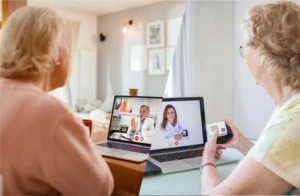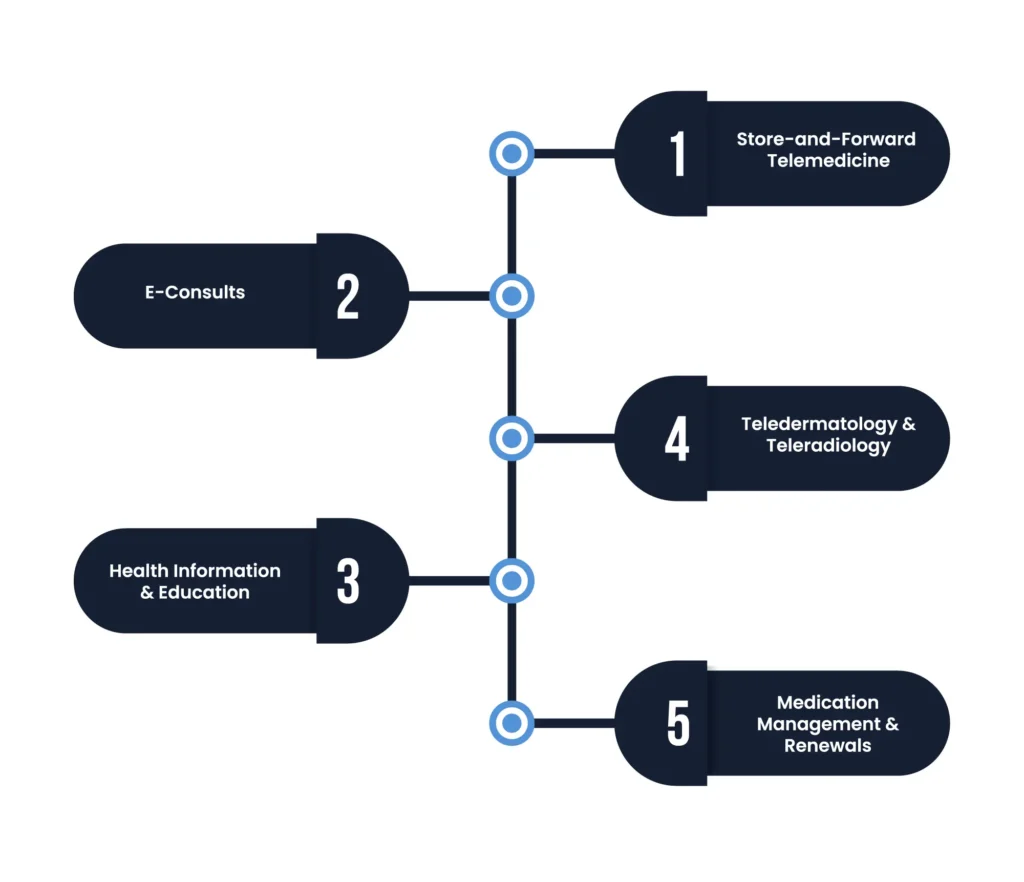

As we witness an immense surge in telehealth services, you might come through a maze of options and terminologies. If you’ve found yourself delving into the world of telemedicine lately, you’ve likely encountered terms like ‘synchronous’ and ‘asynchronous’ telehealth options.
These two buzzwords are more than just fancy jargon; they represent distinct approaches to virtual healthcare that can significantly impact your experience. In this blog, we’re going to demystify these terms for you. We’ll delve into what each of these telehealth options entails, how they differ from one another, and most importantly, guide you in identifying the ideal situations for each.
Whether you’re a patient seeking convenience or a healthcare provider looking to expand your services, understanding these concepts is crucial. So, let’s dive in and unravel the mystery of synchronous versus asynchronous telehealth!
When we talk about telehealth, the term ‘synchronous telehealth’ often surfaces, but what exactly does it mean? Let’s break down the synchronous definition in the context of telemedicine.
Synchronous telehealth refers to real-time interactions between a patient and a healthcare professional, typically conducted via a video conference. It’s not just a popular form of telehealth; it’s the backbone of remote healthcare, facilitating direct and immediate communication.
During a synchronous telehealth session, healthcare providers can engage with patients much like they would in a traditional in-person visit. This real-time interaction allows for immediate discussion of the patient’s concerns and health history, enabling providers to conduct remote examinations, diagnose conditions, and suggest treatment plans.
It’s a dynamic and interactive method where healthcare professionals can also provide e-prescriptions, make referrals to specialists, and, if necessary, arrange for an in-person consultation.
One of the key advantages of synchronous telehealth is its integration with technology. Patient data gathered during these sessions can be seamlessly uploaded to secure electronic health records (EHR) or general practice management systems. This efficient, real-time approach to healthcare not only saves time but also ensures a high level of accuracy and continuity in patient care.
Asynchronous telemedicine, often termed as ‘store-and-forward’, involves collecting medical data and then transmitting this information to a healthcare provider at a later time. This method is fundamentally different from synchronous telehealth, as it does not require both parties to be present simultaneously.
This definition of asynchronous telemedicine highlights its flexibility, allowing patients to send health information such as symptoms, images, or test results at their convenience, which the healthcare providers can then review at a later time.
This approach is particularly beneficial in situations where immediate interaction is not necessary or possible. It’s an efficient way to manage time-sensitive data and provides a level of convenience and accessibility that synchronous methods may not offer.
Aspect | Synchronous Telehealth | Asynchronous Telehealth |
Interaction Timing | Real-time interaction | Interaction does not occur in real-time |
Flexibility | Requires scheduling and simultaneous availability | Highly flexible, without the need for simultaneous presence |
Patient-Provider Engagement | Direct and immediate communication, similar to in-person visits | Indirect communication; information is sent and reviewed later |
Suitability | Ideal for immediate consultations, diagnoses, and treatment discussions | Best for non-urgent consultations, follow-ups, and information sharing |
Technology Utilization | Relies heavily on video conferencing technology | Utilizes ‘store-and-forward’ technology for data transmission |
Data Management | Patient data can be uploaded immediately to EHR | Data is collected and sent for later review, suitable for ongoing monitoring |

Live Video Consultations: Direct, real-time video calls between patients and healthcare providers for diagnosis, treatment advice, and immediate care.
Virtual Check-ups: Regular health check-ups conducted via live video, often used for follow-up appointments or routine health monitoring.
Remote Patient Monitoring (RPM): Real-time monitoring of patients’ vital signs and health status through connected devices, with immediate feedback from healthcare professionals.
Telepsychiatry: Live, interactive sessions for mental health services, including therapy and counseling.
Emergency Services: Immediate consultation and diagnosis for urgent medical issues via real-time video conferencing.

Store-and-Forward Telemedicine: Sharing of patient health information, such as lab reports, images, and patient records, with healthcare providers for later review.
e-Consults: Healthcare providers consult with specialists or colleagues about a patient’s condition via secure platforms, without the patient being present.
Health Information and Education: Providing access to health information, educational materials, and resources that patients can review at their convenience.
Teledermatology and Teleradiology: Patients send images or scans for evaluation by specialists who provide feedback and diagnosis asynchronously.
Medication Management and Renewals: Patients request medication renewals and manage prescriptions, which healthcare providers review and approve at a later time.
Each of these services plays a crucial role in the broad spectrum of telehealth, offering patients and healthcare providers flexibility, efficiency, and a tailored approach to healthcare delivery.
Synchronous telehealth offers significant benefits for both healthcare providers and patients, enhancing the overall quality and accessibility of healthcare. Here’s an overview of the key advantages for each group:
Asynchronous telehealth, with its unique approach to healthcare delivery, offers a range of benefits for both healthcare providers and patients. These benefits cater to the evolving needs of modern healthcare, emphasizing convenience, efficiency, and accessibility.
Asynchronous telehealth’s benefits underscore its role in complementing traditional healthcare models, offering a flexible, efficient, and patient-centric approach to medical care.
In-person care refers to the traditional model of healthcare delivery, where patients and healthcare providers physically meet in a clinical setting. This face-to-face approach is the cornerstone of healthcare systems worldwide and encompasses a wide range of medical services. In-person care is characterized by direct, physical interaction between patients and healthcare professionals, whether it’s for consultation, diagnosis, treatment, or follow-up.
Telehealth and in-person care, while both integral to modern healthcare, differ significantly in their approach and execution. Here are some key aspects where these two modes of healthcare diverge, each highlighting their unique characteristics.
Telehealth: Requires a digital platform, stable internet connection, and privacy for the patient.
In-Person Care: Involves a clinical or hospital setting equipped with medical equipment and infrastructure.
Telehealth: Limited in conducting physical examinations; relies on patient-reported symptoms and visual inspections via video.
In-Person Care: Enables comprehensive physical examinations and immediate diagnostic testing using medical equipment.
Telehealth: Interaction is digital, which can be less personal and may affect the depth of the patient-provider relationship.
In-Person Care: Offers a more personal interaction, fostering better rapport and empathetic understanding.
Telehealth: Not suitable for emergency situations where immediate physical intervention is required.
In-Person Care: Essential for emergencies, as it provides immediate, hands-on care and interventions.
Telehealth: Heavily reliant on technology, which can lead to issues if there are technical malfunctions or connectivity problems.
In-Person Care: Less dependent on technology for interaction, focusing more on direct human contact and physical tools.
These differences highlight the distinct roles telehealth and in-person care play in the healthcare ecosystem, each with its own set of advantages and limitations. While telehealth expands accessibility and convenience, in-person care remains crucial for more comprehensive medical interventions and emergencies.
Throughout this exploration of Synchronous vs. Asynchronous Telehealth, we’ve seen how each style caters to different aspects of patient care and healthcare provider needs. Synchronous telehealth shines in real-time, direct patient engagement, ideal for immediate consultations and interactive care. Asynchronous telehealth, on the other hand, excels in flexibility and convenience, allowing for healthcare delivery that transcends time barriers.
Incorporating these telehealth styles, Global CCM’s software solutions stand out by providing robust support for both synchronous and asynchronous interactions. Their platform facilitates real-time video consultations, ensuring effective synchronous communication. Simultaneously, it supports the asynchronous exchange of medical information, like patient records and diagnostic data, crucial for time-independent consultations. This dual functionality not only enhances the efficiency of healthcare delivery but also ensures a broader reach, catering to diverse patient needs and schedules.
Talk to an Expert Now